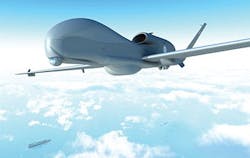Navy to locate mission-control center for fleet of maritime-patrol UAVs at Jacksonville NAS
JACKSONVILLE NAS, Fla., 16 Aug. 2013. U.S. Navy officials plan to build a mission-control complex for unmanned maritime patrol aircraft at Jacksonville Naval Air Station, Fla. The complex will provide command and control for the Navy's future fleet of Northrop Grumman MQ-4C Triton Broad Area Maritime Surveillance (BAMS) unmanned aerial vehicles (UAVs).
BAMS unmanned aircraft will work together with the Navy's future fleet of P-8A Poseidon long-range manned maritime patrol aircraft to provide combat information to expeditionary forces, carrier strike groups, and other Navy fighting forces. Specifically, BAMS UAVs will help locate and track potentially hostile surface ships and submarines.
The MQ-4C BAMS UAV will provide intelligence of broad open-ocean areas, and post contacts to the Global Information Grid (GIG) in support of a variety of intelligence activities. The future BAMS mission-control complex at Jacksonville NAS will help consolidate and disseminate data from BAMS aircraft, and will help coordinate BAMS operations.
The BAMS mission-control complex at Jacksonville NAS will be the operations center for all activities of the BAMS UAVs, says U.S. Rep. Ander Crenshaw, R-Fla., the congressman who represents Jacksonville, NAS. A portion of the Navy's future P-8 manned aircraft also will be based at Jacksonville NAS.
Today the base is a major hub for the Navy's Atlantic and Caribbean maritime patrol and airborne anti-submarine warfare (ASW) operations, and is home for many Navy East Coast-based P-3 Orion maritime patrol squadrons -- the aircraft the P-8 eventually will replace.
Several of the future MQ-4C BAMS unmanned aircraft also will be based at Jacksonville NAS when the new UAVs enter service in 2015. Other MQ-4C UAVs will be based at Point Mugu NAS, Calif.; Kadena Air Base, Japan; Andersen Air Force Base, Guam; Sigonella NAS, Italy, as well as at installations on Hawaii and Diego Garcia.
The MQ-4C Triton will be a forward deployed, land-based, autonomously operated system that provides a persistent maritime persistent intelligence, surveillance, and reconnaissance (ISR) capability using a multi-sensor mission payload that blends maritime radar, electro-optical/infrared (EO/IR) sensors, electronic support measures (ESM), automatic identification system (AIS) and basic communications relay.
The MQ-4C Triton air vehicle is based on the U.S. Air Force RQ-4B Global Hawk UAV, while the Triton's sensors are based on components and systems already fielded. The MQ-4C's ability to operate within a range of 2,000 nautical miles on missions lasting as long as 30 hours will enable the P-8A aircraft to focus on its core missions of ASW, anti-ship warfare, and multi-intelligence operations.
The MQ-4C UAV is 48 feet long, 131 feet wide, 15 feet high, and can fly as fast as 310 knots at altitudes to 60,000 feet. The UAV will be able to fly unrefueled for nearly 10,000 nautical miles. The MQ-4C crew, who will operate at BAMS mission-control complexes like the one to be built at Jacksonville NAS, will consist of the aircraft operator, mission and communications commander, and two sensor operators.
Building the BAMS mission-control complex will be the construction firm of Whitesell-Green Inc. in Pensacola, Fla., which won a $15.9 million contract Wednesday to build the complex.
Whitesell-Green will construct a new freestanding two-story building to house the BAMS mission-control complex, which will have two electromagnetic interference- (EMI) shielded mission control systems, a tactical operations center with sensitive compartmented information facility spaces, and several roof-top mounted antennas.
The construction company also will renovate some existing interior spaces at Jacksonville NAS, including a reconfigured command suite. Whitesell-Green also will prepare space at a remote site south of the new BAMS mission-control complex for the installation's antennas.
The complex should be finished by December 2014. Awarding the building contract were officials of the The Naval Facilities Engineering Command, Southeast, in Jacksonville, Fla.
For more information contact Whitesell-Green Inc. online at www.whitesell-green.com, or the Naval Facilities Engineering Command, Southeast, at https://portal.navfac.navy.mil.
